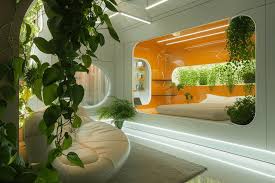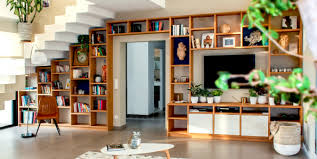Creating a sustainable home design is not just about incorporating eco-friendly features; it’s about designing a living space that harmonizes with the environment while also providing comfort and functionality. In today’s world, as awareness about climate change and resource depletion grows, more homeowners are opting for green building solutions to reduce their carbon footprint and promote a healthier lifestyle. Sustainable home design involves smart choices in materials, energy use, water conservation, and indoor environmental quality. Let’s explore the various elements that make up an eco-friendly, sustainable home and how they can help both the planet and your wallet.
What is sustainable home design?
Sustainable home design refers to the practice of designing and constructing homes in a way that minimizes their environmental impact. The main focus is on reducing energy consumption, utilizing renewable resources, and improving the overall quality of life for the inhabitants. A sustainable home design incorporates various features that contribute to environmental conservation, such as solar panels, energy-efficient appliances, and sustainable materials that reduce waste.
The goal of sustainable design is to create homes that not only reduce their carbon footprint but also have long-term benefits for the environment. These homes are designed to function efficiently while reducing their reliance on non-renewable resources. With an increasing number of green-certified building materials and technologies available, creating an eco-friendly home has become easier and more accessible for homeowners everywhere.
Key Principles of Sustainable Home Design
When creating a sustainable home, there are several key principles that must be followed to ensure efficiency, durability, and a reduced environmental impact. These principles guide architects and homeowners in making informed decisions about their building materials, energy systems, and overall design. Some of the core principles of sustainable home design include:
1. Energy Efficiency
One of the primary goals of a sustainable home is to reduce energy consumption. Energy-efficient homes are designed with insulation, airtightness, and high-performance windows and doors to reduce heat loss in winter and keep the home cool during the summer. Additionally, utilizing energy-efficient appliances and lighting fixtures further reduces electricity usage. By designing homes that maximize energy efficiency, homeowners can enjoy lower utility bills while contributing to the conservation of resources.
2. Sustainable Materials
The materials used in the construction of a sustainable home play a significant role in minimizing its environmental impact. Recycled, locally sourced, and renewable materials help reduce waste and the carbon footprint associated with the transportation of goods. Bamboo, reclaimed wood, recycled metal, and low-VOC (volatile organic compound) paints and finishes are just a few examples of materials that contribute to a more eco-friendly design.
3. Water Conservation
Another key principle of sustainable home design is water conservation. By incorporating water-efficient fixtures, rainwater harvesting systems, and greywater recycling systems, homeowners can significantly reduce their water usage. Sustainable homes are designed to minimize water waste, ensuring that every drop counts. This not only helps conserve a vital natural resource but also reduces water bills.
Benefits of Sustainable Home Design
Investing in a sustainable home design has numerous benefits, both immediate and long-term. These advantages extend beyond environmental conservation, as green homes often offer enhanced living conditions and financial savings for homeowners.
1. Lower Utility Bills
One of the most appealing benefits of sustainable home design is the potential for reduced energy and water bills. By using energy-efficient appliances, implementing solar power, and optimizing natural light, homeowners can significantly cut their utility expenses. Over time, these savings can add up, making the initial investment in sustainable design worthwhile.
2. Healthier Living Environment
Sustainable homes are built with the health and well-being of the residents in mind. Green homes typically feature superior indoor air quality due to the use of non-toxic materials and proper ventilation. This contributes to a healthier living environment, reducing the risk of respiratory issues and allergies.
3. Increased Property Value
Eco-friendly homes are becoming increasingly desirable in the real estate market. Many homebuyers are willing to pay a premium for properties that incorporate sustainable design elements. As sustainability becomes a higher priority for consumers, homes with energy-efficient features, sustainable materials, and eco-friendly technologies are often valued higher than traditional homes.
How to Incorporate Sustainable Features into Your Home
If you are interested in creating a sustainable home, there are several ways you can incorporate eco-friendly features into your existing property. Making small changes can have a significant impact on your home’s energy efficiency and environmental footprint. Here are some ideas to get started:
1. Upgrade Insulation and Windows
Improving your home’s insulation and installing energy-efficient windows can dramatically reduce heating and cooling costs. By ensuring your home is properly sealed, you prevent heat from escaping in winter and keep cool air inside during the warmer months. Double-glazed windows, insulated doors, and well-insulated walls are great additions for any eco-friendly home.
2. Invest in Solar Power
Solar energy is one of the most effective ways to reduce reliance on non-renewable energy sources. Installing solar panels on your roof can significantly cut down on electricity costs, especially if you live in an area with plenty of sunlight. In addition to lowering utility bills, solar energy systems are a renewable source of power that can contribute to a sustainable lifestyle.
3. Use Water-Efficient Fixtures
To conserve water, consider installing low-flow faucets, showerheads, and toilets. These fixtures can drastically reduce water usage without sacrificing performance. Additionally, consider installing a rainwater harvesting system that captures rainwater for use in irrigation and outdoor activities.
Sustainable Home Design and Smart Technologies

As technology continues to advance, smart home devices have become an integral part of sustainable home design. These devices allow homeowners to monitor and control various aspects of their home, such as lighting, heating, and security, all from the convenience of their smartphone. By integrating smart technology, homeowners can further optimize their energy consumption and make their homes more efficient.
1. Smart Thermostats
A smart thermostat is an excellent tool for reducing energy consumption. These devices learn your schedule and adjust the temperature accordingly, ensuring that your home is comfortable when you need it but not wasting energy when you’re away. Some models even allow you to control the temperature remotely, making it easier to manage energy use.
2. Energy Monitoring Systems
Energy monitoring systems provide real-time data on your home’s energy usage, allowing you to identify areas where you can save. By tracking your electricity consumption, you can make informed decisions about when to use energy-intensive appliances and how to reduce waste.
3. Automated Lighting
Automated lighting systems can help reduce energy consumption by ensuring lights are only on when needed. Motion sensors, timers, and smart lightbulbs can all work together to minimize electricity usage while providing the right amount of light for each room.
Conclusion: Why Sustainable Home Design is the Future
Sustainable home design is not just a passing trend—it is the future of home construction and living. With growing concerns about climate change and environmental degradation, more people are recognizing the importance of adopting eco-friendly practices in their homes. From energy-efficient systems to sustainable materials and water conservation techniques, there are numerous ways to make your home more environmentally friendly.
By investing in sustainable home design, homeowners can enjoy a range of benefits, including reduced energy bills, improved health, and a smaller environmental footprint. With the added bonus of increased property value, the long-term advantages of green homes are undeniable. Whether you are building a new home or renovating an existing one, incorporating sustainable features is an investment that will pay off for years to come.
Sustainable home design offers a brighter, more environmentally conscious future for everyone, and it all starts with making the right choices today.
